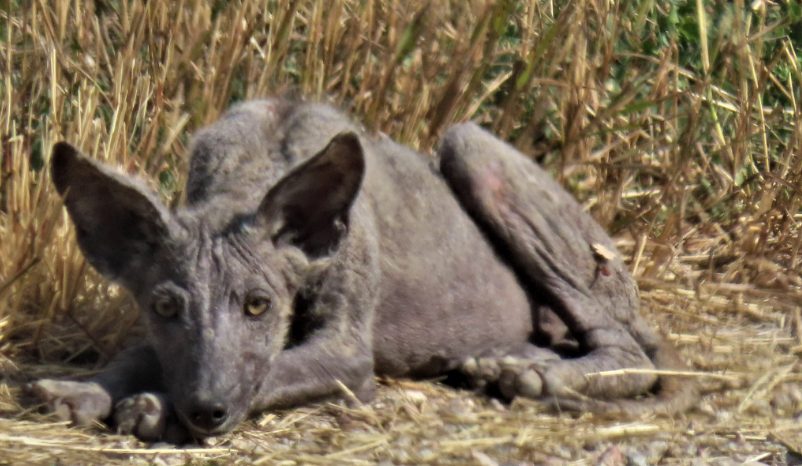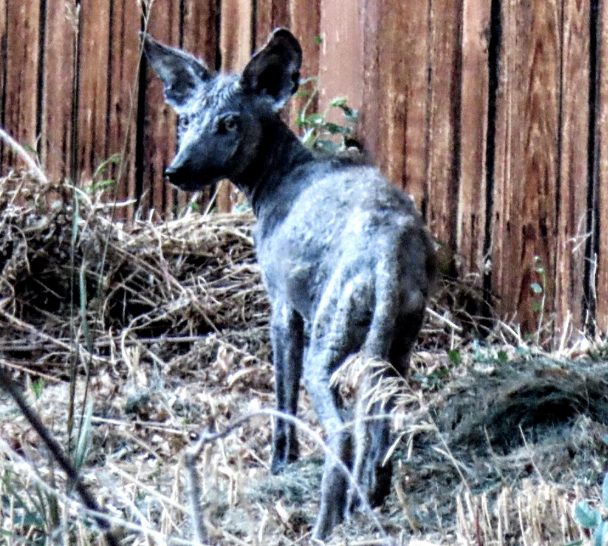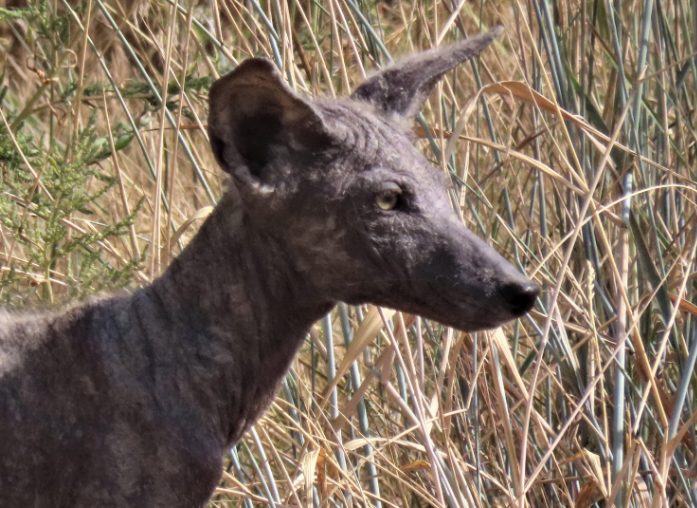This writing by Will Falk outlines the harm anticoagulant rodenticides can do to our non human kin and why they must be stopped.
By Will Falk
The first time I saw a coyote with mange my heart broke.
Most of her fur was gone. Her skin, covered with scabs and lesions, had a sickly pink pallor. Her tail seemed stuck between her legs. And, her movements, as she stumbled through a ditch next to a Colorado country road, were lethargic and listless. Just the sight of her made my own skin chafe and itch. As I hugged myself to ward away the horror, my fingernails dug into my own skin, scratching at the backs of my arms. The experience educated me in the realest ways about what the phrase “it made my skin crawl” truly means.
After witnessing this, I had to know more about what I had seen. I learned that this coyote was suffering from what scientists call sarcoptic mange, which is caused by mites who live in the skin of many wild canids. In burrowing into the animals’ skin to lay their eggs, these mites cause intense irritation and itchiness, scabbing, and hair loss. An animal affected by mange can develop secondary bacterial skin infections, too. Worst of all, mange can be fatal for animals if left untreated. With the loss of their fur, animals affected by mange often freeze to death. And, if the cold doesn’t kill them, those secondary bacterial skin infections exacerbated by excessive scratching will.
While mange does occur naturally,
recent research suggests that the widespread use of anticoagulant rodenticides – a type of rat poison – weakens the immune systems of animals and makes them more susceptible to mange. A 2017 study linked anticoagulant exposure to mange in bobcats, for example. Notoedric mange – which affects felines and is closely related to the sarcoptic mange that affects coyotes – ravaged the population of urban bobcats at Santa Monica Mountains National Recreation Area in southern California from 2002-2005. After mange was detected in 2001, the average annual survival of these bobcats plummeted by 49%. Mange-infected bobcats were necropsied and 98% of infected individuals had been exposed to anticoagulant rodenticides. These bobcats also had greater amounts of anticoagulant rodenticides than bobcats who did not die with mange.
After reading the results of the bobcat study, and against my better judgment, I was compelled to find images of bobcats with mange. I was met with the stares of blue-eyed bobcats, stripped of fur and looking like hairless, Sphynx cats. Unlike Sphynx cats, these bobcats weren’t bred selectively to be hairless. Their hair had been stripped and their skin ravaged by mites because they had eaten rodents who had eaten too many anticoagulant rodenticides.
What exactly are anticoagulant rodenticides?
Anticoagulant rodenticides are widely used as a cheap and effective means for killing rodents. These rodenticides disrupt coagulation and cause fatal hemorrhaging. In simple terms, rodenticides cause the creatures who eat them to bleed more easily. Similar to the way a minor wound to a human taking a blood-thinner can cause a human to bleed out, rodents who have ingested anticoagulant rodenticides bleed to death.
Rodents exposed to anticoagulant rodenticides don’t just bleed to death – they bleed to death slowly. Rodents are very intelligent. They are so intelligent, in fact, that the use of toxins that immediately harm a rodent have proven to be completely ineffective because rodents learn not to eat things that instantaneously kill their kin. Anticoagulant rodenticides are effective because they can be mixed with rodents’ favorite foods as bait and the 3-7 days it takes for exposure to kill rodents makes it very difficult for them to understand what is killing them.
Anticoagulant rodenticides have been in use since the late 1940s, and by the early 1980s, genetic resistance to what are now called “first-generation anticoagulant rodenticides” was reported in rats and mice around the world. These first-generation anticoagulant rodenticides include the chemicals diphacinone, warfarin, coumatetralyl, and chlorophacinone and they killed rodents only after prolonged or repeated exposure. Due to genetic resistance, second-generation anticoagulants developed. These chemicals – which include difenacuom, brodifacoum, bromadiolone, difethialone, and flocoumafen – are much more potent, have a longer half-life, and can kill rodents after only one feeding. This potency poses an increased risk of harm non-target species.
Inevitably, predators who eat rodents are exposed to the rodenticides ingested by their prey.
In one study, 70% of mammals tested in California were found to have been exposed to anticoagulants. Anticoagulant rodenticides were detected in 49% of the raptors tested in New York City, including in 81% of the great horned owls tested. A study of three species of owls in British Columbia and the Yukon detected anticoagulant rodenticides in 62% of barn owls, 92% of barred owls, and 70% of great horned owls. In sum, the Canadian researchers detected anticoagulant rodenticides in 70% of 164 owls. They also confirmed that rodenticides killed two barn owls, three barred owls, and one great horned owl.
As described above, rodents usually do not die for several days after consuming a lethal dose. This means they may continue to move through habitat shared with predators and they may continue to feed on poisoned bait. Additionally, rodents – exposed to anticoagulant rodenticides and who may be hemorrhaging internally – spend more time in open areas, stagger as they move, and sit motionless before death. All of this makes them easier prey for predators.
Coyotes, and especially urban coyotes, rely heavily on rodents for food.
It appears anticoagulant rodenticides are harming coyotes. Scientists in the Denver metropolitan area, for example, researching the effects of anticoagulant rodenticides on coyotes, found a dead juvenile male with no obvious external injuries or other signs of trauma. However, when they necropsied the young coyote, they “found free blood in the abdominal cavity” and “a puncture wound [that] was present on the left side of the body overlying the spleen but not penetrating the abdominal wall.” They determined that the coyote died from “acute severe hemorrhage, disproportionate to the amount of trauma observed.” The coyote’s liver tested positive for an anticoagulant rodenticide. In other words, it’s likely that the rodenticide in the coyote’s body turned a minor injury lethal.
These scientists found another young male coyote dead on a two-lane road “with minor evidence of skin tearing over the ventral neck and chest.” When they necropsied the coyote, they found that the coyote’s chest was filled with blood and they concluded that the coyoted was killed by “severe acute hemorrhage, disproportionate to the mild to moderate trauma received from being hit by a vehicle.” The scientists suspected rodenticide exposure. And, sure enough, the coyote’s liver tested positive for two types of anticoagulant rodenticides. Again, rodenticides turned a small injury into a coyote’s death.
There have been many more studies demonstrating the harmful effects anticoagulant rodenticides have on non-rodent species.
Some of these studies include harmful effects on buzzards, mountain lions, otters, endangered European mink, polecats, and, even, freshwater fish. Anticoagulants, in fact, act on all vertebrates – not just the rodents they’re intended for. Scientists have also discovered anticoagulant rodenticides in raw and treated wastewater, sewage sludge, estuarine sediments, and particulate matter suspended in the air.
For brevity’s sake, I’ll stop here. But, it bears mentioning that as I sifted through study after study describing the havoc anticoagulant rodenticides wreak on natural communities and felt my stomach grow increasingly sour, I learned the literal meaning of another phrase: ad nauseum. It is also important to remember that, despite the amount of studies being conducted on the effects of anticoagulant rodenticides on non-target wildlife, scientists caution us that most of this poisoning remains undetected because the necropsy and liver analysis required is labor and cost intensive. Similarly, unless an animal is being tracked through radiotelemetry, finding dead animals in a non-decomposed state, is difficult.
***
After learning about problems with anticoagulant rodenticides, the torturous manner in which these chemicals kill, and how they are making predators of rodents more susceptible to mange, most people want to know:
What can I do?
This is the wrong question. Don’t ask: What can I do? Ask: What needs to be done? What do bobcats – blue eyes unblinking despite the pain of internal hemorrhaging – need us to do? What do coyotes – scraping their inflamed skin against fence posts, the corners of concrete walls, and rough tree trunks – need us to do? What do rodents – intelligent, sociable, and bleeding to death – need us to do?
Rodents, and all those who eat them, need us to stop the manufacture and application of anticoagulant rodenticides. And, they need this to happen as quickly as possible. This is, of course, much easier said than done.
Individual home or other property owners, as opposed to government or business entities, account for a portion of total anticoagulant rodenticide use. If these individuals could be convinced to live and let rodents live, or to employ non-lethal, non-toxic measures such as blocking holes and other openings rodents use to access buildings, practicing better sanitation, or trapping rodents and removing them to better habitat, then the total use of anticoagulant rodenticides could be reduced.
There are barriers making it unlikely that individual property owners will forego the use of anticoagulant rodenticides:
First, fear of rodents is so pervasive in the dominant culture that there are multiple words to describe this fear including musophobia (fear of mice specifically), murophobia (fear of the taxonomic family Muridae, which includes mice and rats), and suriphobia (which comes from the French souris meaning “mouse”). Similarly, calling someone a “rat” is a grave insult.
Second, anticoagulant rodenticides are simply more economical. Sealing up holes in a house and live-trapping rodents can be costly and can require much more labor than using poison. In fact, a member of California’s Department of Consumer Affairs, Structural Pest Control Board recently estimated that pest control services employing only sanitation, exclusion of rodents, and removal of harborage can be 2-5 times more costly than using rodenticide due to labor and material costs.
I want to be clear here: I am not saying we shouldn’t try to convince everyone we can to stop using anticoagulant rodenticides. This is, of course, one reason I wrote this piece. I am saying, however, that coyotes, bobcats, other predators of rodents, and rodents, themselves, need us to do much more than to simply refuse to stop using anticoagulant rodenticides in our own homes.
Many people assume that if homeowners stopped using these rodenticides the problem would go away. Unfortunately, this is not the case. National and global anti-rodenticide market data are protected by business privacy laws as
“confidential business information.”
However, it’s safe to say that while individual, residential use of anticoagulant rodenticides accounts for a portion of global rodenticide use, governments and agricultural corporations are likely the biggest users of anticoagulant rodenticides.
Statistics from California tend to support this point. In 2012, California imposed stricter regulations on second-generation anticoagulant rodenticides including restricting sales of these chemicals to the general public. Then, in 2014, they imposed a new round of restrictions that were specifically intended to restrict the access of homeowners to second-generation anticoagulant rodenticides. But, using data from the California Department of Pesticide Regulation’s Pesticide Use Reporting database, it does not appear that the amount of second-generation anticoagulant rodenticides applied between 2012-2017 was significantly reduced despite the new regulations.
So, if homeowners are only part of the problem, and governments and corporations are the worst offenders, how do we stop governments and corporations from using anticoagulant rodenticides?
A common response is: change the law. It is highly unlikely, however, that governments will ever impose a true ban on anticoagulant rodenticides. The agricultural lobby is one of the most powerful political forces in American politics. Meanwhile, in the United States, rodents are responsible for an estimated $19 billion in economic damages annually through the consumption and contamination of stored grains. Rodents don’t just pose a threat to agricultural interests, either. A British study, which attempted to determine the cost of physical damage to the built environment caused by rodents, estimated that rodents cost the British economy £200 million per year.
An astute reader may be saying to herself: “Didn’t California recently ban anticoagulant rodenticides?” And, of course, despite the headlines, California did not ban anticoagulant rodenticides. To understand this, we must look to the actual text of the California Ecosystems Protection Act of 2020 (also known as Assembly Bill No. 1788). Courts applying law do not rely on newspaper headlines – they rely on what a piece of legislation actually says.
The pertinent section (12978.7(c)) reads:
“Except as provided in subdivision (e) or (f), the use of any second generation anticoagulant rodenticide is prohibited in this state until the director makes the certification described in subdivision (g).”
So, first, the prohibition only applies to second generation anticoagulant rodenticides and excludes the less potent but still deadly first generation anticoagulant rodenticides.
Second, if we scroll down to the exceptions provided in subdivisions (e) and (f), we see how hollow this “prohibition” really is. Subdivision (e) declares that the prohibition does not apply to governmental agency employees who use second generation anticoagulant rodenticides for public health activities or for protecting water supply infrastructure and facilities; to mosquito or vector control districts; to efforts to eradicate nonnative invasive species on offshore islands; to efforts to control an actual or potential rodent infestation associated with a public health need, as determined by a declaration from a public health officer; or for further research into the dangers posed by second generation anticoagulant rodenticides.
Subdivision (f) creates exceptions to the prohibition for medical waste generators and for “agricultural activities” conducted at warehouses used to store foods for human and animal consumption; slaughterhouses; canneries; factories; breweries; an agricultural production site housing water storage and conveyance facilities; and agricultural production sites housing rights-of-way and other transportation infrastructure.
The power of agricultural interests should be clear from these lists of exceptions to this so-called “prohibition” on second generation anticoagulant rodenticides.
It should also be clear that the California Ecosystems Protection Act of 2020 has not banned anticoagulant rodenticides. At best, the law simply prevents individual homeowners and property owners from using a subset of anticoagulant rodenticides while exempting those who likely use second generation rodenticides the most.
To repeat, it is unlikely that governments will ever truly ban anticoagulant rodenticides. This does not mean that we have no power to stop the manufacture and application of these poisons. It is true that we must raise awareness about the harms of anticoagulant rodenticides. And, anyone who reads this, please, please stop using these toxic chemicals. Similarly, pushing for legislation to limit the use of anticoagulant rodenticides can help. But, if we truly want to protect rodents, and the predators who eat them, from horrible deaths, and if we truly want to keep these poisons out of the natural communities we depend on for life, we will have to do it ourselves.
As with any truly effective tactic that impedes humans’ ability to destroy the natural world, stopping anticoagulant rodenticides will require exceptional bravery. To find that bravery, I return to the first mangy coyote I saw. If it was me, and my skin was covered in itchy sores and lesions, my organs were hemorrhaging blood, and my movements were growing ever slower, I’d likely give in, lay down, and let death take me.
But, that first mangy coyote I watched struggle to keep moving through a roadside ditch did not give up. She kept moving in an effort to fulfill her species’ ancient role as a trickster lesson-giver. She wanted us to see her. She wanted us to know what happened to her. And, she wanted us to stop those who hurt her.
Will Falk is a DGR member, lawyer for the natural world and is currently journeying in conversation with the Ohio River. You can read about Will’s journey with the Ohio River here.




I cried even more over this. Had no idea bees starving along with bats, birds, insects et al all because of electric. So is this true? https://www.cellphonetaskforce.org/wp-content/uploads/2020/03/Is-the-Sky-Really-Falling.pdf?fbclid=IwAR2oQjGQlXeh3a4fFxzCPCPnCYSHc-Dgg091GZoT9D4mFpjMiy1sTaIqcnk
All pesticides and other synthetic chemicals are immoral and should be eliminated. No point in trying to go through the tens of thousands of them in use, they all cause harm to the Earth and everything living here. But being the Nazis of the species, humans don’t care about harm to anything but themselves, and in fact they WANT to kill other species that they consider pests. It’s clear who the real pests are, and this essay is a perfect example.
Posting again. https://www.cellphonetaskforce.org/wp-content/uploads/2020/03/Is-the-Sky-Really-Falling.pdf?fbclid=IwAR2oQjGQlXeh3a4fFxzCPCPnCYSHc-Dgg091GZoT9D4mFpjMiy1sTaIqcnk
So the source for your assertion that the 1918 pandemic was caused by electricity rather than a virus and was not contagious is a book written by you.
I’d laugh but this kind of bullshit is not at all funny.
@Heidi Hall
One of the reasons that ridiculous conspiracy theories like this are propagated is the industries and their lackeys in government lie about the harms that industries cause. Whether you want to look at this through the western science intellectual lens — all actions have equal and opposite reactions — or the spiritual lens — karma — there can be no doubt that non-ionizing radiation causes some bad effects because it does not occur naturally. Just because western science hasn’t been able to identify those effects doesn’t at all mean that they don’t exist. So while Janet comes off as a conspiracy nutcase, there is at least a grain of truth for the basis of her claim.
And BTW, wireless telegraphy would be a form of non-ionizing radiation. Calling it “electricity” is inaccurate.
Heidi, I got two questions for you:
1) do you know how exactly virologists “discover” new viruses?
2) do you know how they prove, experimentally, that a certain alleged virus is the cause of a certain disease?